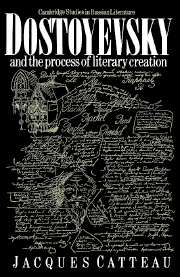Book contents
- Frontmatter
- Contents
- Preface to the English edition
- List of abbreviations
- General editor's note on transliteration and references
- General introduction
- PART I The creative environment
- PART II The process of creation
- Part III Time and space in the world of the novels
- Introduction
- 19 The master of men and hours
- 20 Chronology and temporality in The Idiot
- 21 The ascending spiral
- 22 Time of power and power of time
- 23 The havens of eternity
- 24 The dream of space and the space of the real
- 25 The inventory and the expressionist orchestration of scenery and lighting
- 26 The semantics of colour
- 27 The hero in space: sighting and seeing
- Conclusion
- Notes
- Select bibliography
- Index of names
24 - The dream of space and the space of the real
Published online by Cambridge University Press: 18 December 2009
- Frontmatter
- Contents
- Preface to the English edition
- List of abbreviations
- General editor's note on transliteration and references
- General introduction
- PART I The creative environment
- PART II The process of creation
- Part III Time and space in the world of the novels
- Introduction
- 19 The master of men and hours
- 20 Chronology and temporality in The Idiot
- 21 The ascending spiral
- 22 Time of power and power of time
- 23 The havens of eternity
- 24 The dream of space and the space of the real
- 25 The inventory and the expressionist orchestration of scenery and lighting
- 26 The semantics of colour
- 27 The hero in space: sighting and seeing
- Conclusion
- Notes
- Select bibliography
- Index of names
Summary
Full of exaltation, his soul thirsted for freedom, space, vastness.
F. M. Dostoyevsky, The Brothers KaramazovSpace in the novel
There is no time without space or space without time. Bakhtin created the instrument of the chronotope, whose name, if not significance, is taken from Einstein's theory of relativity especially to study their interrelationship and thus began a new, though perhaps too systematic, ‘historical poetics’. Dostoyevsky has an original place here between Flaubert and Tolstoy, and his novels are used to show the chronotopes of the threshold and of the agora, or market-place, where the time of the mediaeval mystery and the carnival hold sway. In fact, Bakhtin is hardly innovating: he is simply changing the names of aspects already studied by other critics. Moreover he admits that these chronotopes are only specific cases and that there are others, complex and varied, in Dostoyevsky's work. Bakhtin is essentially considering geometrical space and has described only two particular relationships between time and space, but in reality space varies according to the frame of reference: it may be geometrical, topological, philosophical or perceptional. In the novels, space is human without philosophical or scientific pretensions; organised by the novelist, perceived and experienced by the hero, it assumes a variety of solid and living forms, such as isolated places, paths, outlines, colours, landscapes. Moreover, novelists vary in their treatment of space – it is not so much the appearance of space that changes in different novels, but the fact that each author gives space a different significance and relates it differently to time.
Information
- Type
- Chapter
- Information
- Dostoyevsky and the Process of Literary Creation , pp. 382 - 386Publisher: Cambridge University PressPrint publication year: 1989
